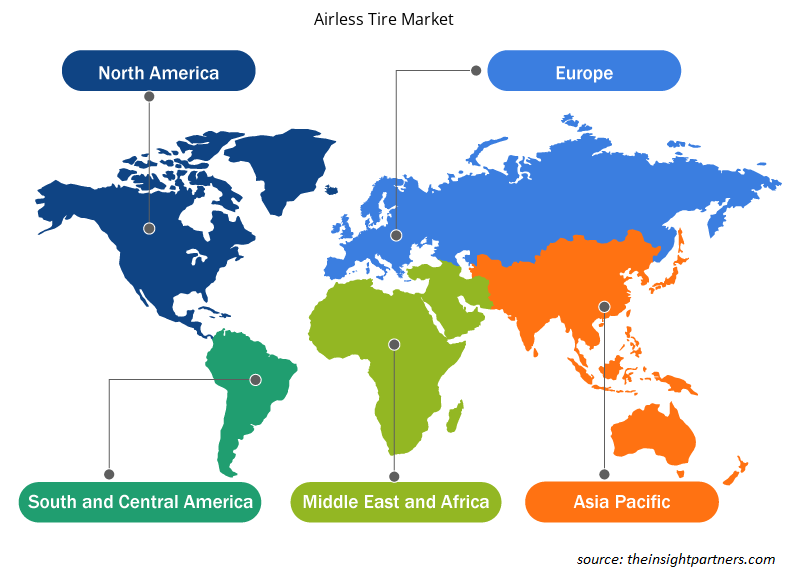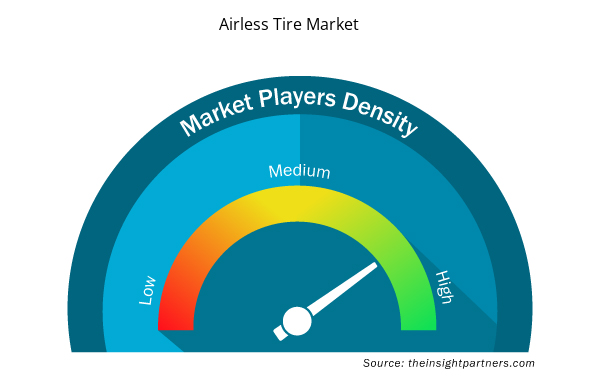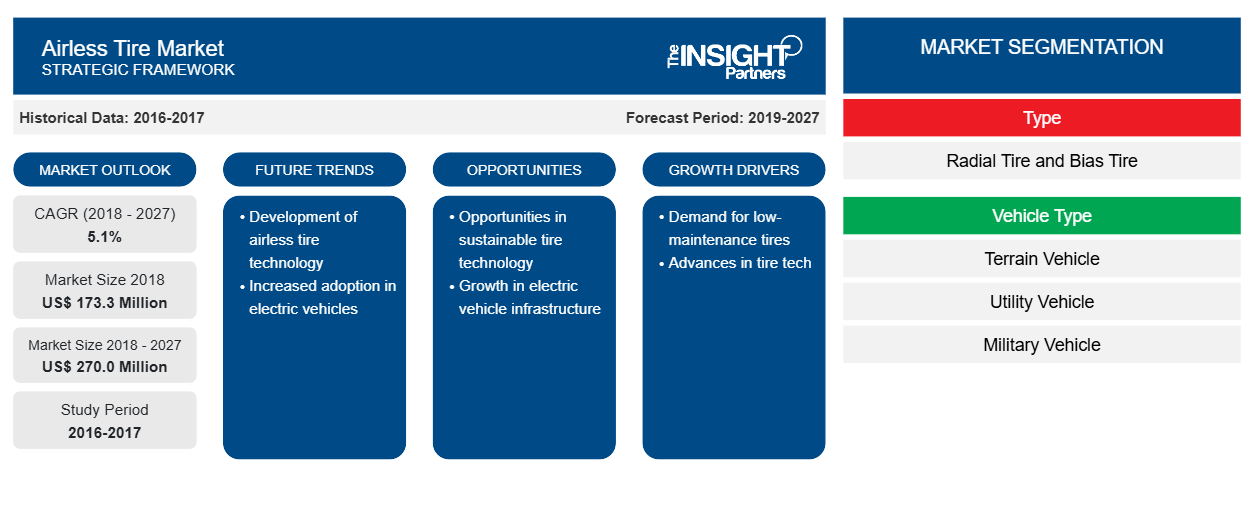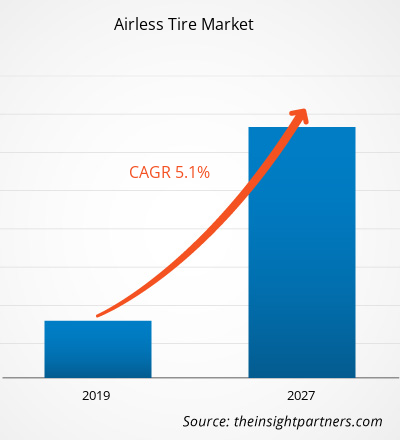In Bezug auf den Umsatz wurde der globale Markt für luftlose Reifen im Jahr 2018 auf 173,3 Millionen US-Dollar geschätzt und soll bis 2027 270,0 Millionen US-Dollar erreichen; im Prognosezeitraum von 2019 bis 2027 dürfte er mit einer durchschnittlichen jährlichen Wachstumsrate von 5,1 % wachsen.
Der Markt für luftlose Reifen ist grob in fünf große Regionen unterteilt: Nordamerika, Europa, APAC, MEA und SAM. Die bedeutendste Region auf dem globalen Markt für luftlose Reifen ist Nordamerika, gefolgt vom asiatisch-pazifischen Raum und Europa. Die Dominanz Nordamerikas auf dem Markt für luftlose Reifen ist darauf zurückzuführen, dass in der Region mehrere Hersteller von luftlosen Reifen ansässig sind, die erheblich von der Forschung und Entwicklung des Produkts profitieren. Die USA sind der größte Markt in Nordamerika sowie auf dem globalen Markt für luftlose Reifen und werden den Markt voraussichtlich im Prognosezeitraum von 2019 bis 2027 dominieren. Der Markt für luftlose Reifen wird im Prognosezeitraum weltweit voraussichtlich stark ansteigen. Die Einführung von luftlosen Reifen in verschiedenen Regionen nimmt bei verschiedenen Fahrzeugtypen stetig zu. Die Vorteile der luftlosen Reifen haben mehrere Branchen beeinflusst, darunter Bauwesen, Landwirtschaft, Handel, Bergbau und Militär. Der Markt für luftlose Reifen befindet sich in einem frühen Stadium, und mehrere etablierte Unternehmen sowie kleinere Akteure sind auf dem globalen Markt tätig.
Passen Sie diesen Bericht Ihren Anforderungen an
Sie erhalten kostenlos individuelle Anpassungen an jedem Bericht, einschließlich Teilen dieses Berichts oder einer Analyse auf Länderebene, eines Excel-Datenpakets sowie tolle Angebote und Rabatte für Start-ups und Universitäten.
- Holen Sie sich die wichtigsten Markttrends aus diesem Bericht.Dieses KOSTENLOSE Beispiel umfasst eine Datenanalyse von Markttrends bis hin zu Schätzungen und Prognosen.
Markteinblicke – Markt für luftlose Reifen
Steigerung der weltweiten Fahrzeugproduktion
Weltweit nimmt die Urbanisierung exponentiell zu. Dadurch steigt auch das durchschnittliche verfügbare Einkommen der Bevölkerung in Großstädten. Die Fahrzeugproduktion hat in der Zeit nach der Rezession seit dem Jahr 2010 ein stetiges Wachstum erfahren. Ein Schlüsselbereich ist der Sektor der Schwermaschinen und Nutzfahrzeuge, der sich durch ein hohes Maß an Innovationstätigkeit und Entwicklungen im Bereich der Verkehrssicherheit auszeichnet . Die Vergrößerung des Fuhrparks hat zu einer Zunahme der Unfälle geführt, die durch verschiedene Faktoren verursacht werden, wie beispielsweise einen ungeeigneten Reifendruck. Schwermaschinen, die mit luftlosen Reifen ausgestattet sind, können im Vergleich zu Luftreifen mehr Gewicht tragen und sind für anspruchsvollere Aktivitäten geeignet.
Typsegment-Einblicke
Je nach Typ kann dieDas Segment der Radialreifen dominierte 2018 den globalen Markt für luftlose Reifen. Bei einem Radialreifendesign sind die Kordlagen im 90-Grad-Winkel zur Fahrtrichtung oder von der Reifenmitte (radial) angeordnet. Bei einem Radialreifen fungieren Lauffläche und Seitenwand als zwei unabhängige Merkmale des Fahrzeugreifens.
Einblicke in das Materialsegment
Materialmäßig dominiert das Gummisegment den globalen Markt für luftlose Reifen. Ein herkömmlicher Reifen besteht aus luftgefülltem Gummi, das mithilfe von Druckluft gepresst wird. Luftreifen dominieren den globalen Reifenmarkt.
Einblicke in das Fahrzeugtypsegment
Basierend auf dem Fahrzeugtyp hatte das Segment der Nutzfahrzeuge 2018 den größten Anteil am globalen Markt für luftlose Reifen. Die Nutzfahrzeuge umfassen verschiedene Fahrzeugtypen, die für zahlreiche Industrieanwendungen eingesetzt werden. Diese Fahrzeuge sind so konzipiert und hergestellt, dass sie im Vergleich zu Personenkraftwagen bestimmte Aufgaben effektiver und effizienter ausführen.
Die Marktteilnehmer konzentrieren sich auf Produktinnovationen und -entwicklungen, indem sie fortschrittliche Technologien und Funktionen in ihre Produkte integrieren, um mit der Konkurrenz mithalten zu können.
- Im Jahr 2019 hat Michelin Tweel Technologies, eine Abteilung von Michelin North America, Inc., einen neuen luftlosen 26-Zoll-Radialreifen mit einer Nabe mit Vierbolzenmuster eingeführt, der für UTV (Utility Vehicle oder Utility Task Vehicle) entwickelt wurde.
- Im Jahr 2018 ist Michelin eine Partnerschaft mit General Motors eingegangen, um den Uptis-Prototyp zu testen und zu erproben, der ab 2024 in Autos zum Einsatz kommen soll.
- Im Jahr 2017 kündigte Toyo Tires die Entwicklung von „Noair“ an, einem neo-futuristischen Airless-Konzeptreifen, der keinerlei Luftbefüllung benötigt.
Der globale Markt für luftlose Reifen ist wie folgt segmentiert:
Markt für luftlose Reifen – nach Typ
- Radialreifen
- Diagonalreifen
Markt für luftlose Reifen – nach Material
- Gummi
- Verbundwerkstoff
Markt für luftlose Reifen – nach Fahrzeugtyp
- Geländefahrzeug
- Nutzfahrzeug
- Militärfahrzeug
Markt für luftlose Reifen – nach Regionen
- Nordamerika
- UNS
- Kanada
- Mexiko
- Europa
- Frankreich
- Deutschland
- Italien
- Vereinigtes Königreich
- Russland
- Restliches Europa
- Asien-Pazifik (APAC)
- China
- Indien
- Südkorea
- Japan
- Australien
- Restlicher Asien-Pazifik-Raum
- Naher Osten und Afrika (MEA)
- Südafrika
- Saudi-Arabien
- Vereinigte Arabische Emirate
- Rest von MEA
- Südamerika (SAM)
- Brasilien
- Argentinien
- Rest von SAM
Regionale Einblicke in den Markt für luftlose Reifen
Die regionalen Trends und Faktoren, die den Markt für luftlose Reifen im Prognosezeitraum beeinflussen, wurden von den Analysten von Insight Partners ausführlich erläutert. In diesem Abschnitt werden auch die Marktsegmente und die Geografie des Marktes für luftlose Reifen in Nordamerika, Europa, im asiatisch-pazifischen Raum, im Nahen Osten und Afrika sowie in Süd- und Mittelamerika erörtert.

- Erhalten Sie regionale Daten zum Markt für luftlose Reifen
Umfang des Marktberichts für luftlose Reifen
| Berichtsattribut | Details |
|---|---|
| Marktgröße im Jahr 2018 | 173,3 Millionen US-Dollar |
| Marktgröße bis 2027 | 270,0 Millionen US-Dollar |
| Globale CAGR (2018 - 2027) | 5,1 % |
| Historische Daten | 2016-2017 |
| Prognosezeitraum | 2019–2027 |
| Abgedeckte Segmente | Nach Typ
|
| Abgedeckte Regionen und Länder | Nordamerika
|
| Marktführer und wichtige Unternehmensprofile |
|
Marktteilnehmerdichte: Der Einfluss auf die Geschäftsdynamik
Der Markt für luftlose Reifen wächst rasant, angetrieben durch die steigende Nachfrage der Endverbraucher aufgrund von Faktoren wie sich entwickelnden Verbraucherpräferenzen, technologischen Fortschritten und einem größeren Bewusstsein für die Vorteile des Produkts. Mit steigender Nachfrage erweitern Unternehmen ihr Angebot, entwickeln Innovationen, um die Bedürfnisse der Verbraucher zu erfüllen, und nutzen neue Trends, was das Marktwachstum weiter ankurbelt.
Die Marktteilnehmerdichte bezieht sich auf die Verteilung der Firmen oder Unternehmen, die in einem bestimmten Markt oder einer bestimmten Branche tätig sind. Sie gibt an, wie viele Wettbewerber (Marktteilnehmer) in einem bestimmten Marktraum im Verhältnis zu seiner Größe oder seinem gesamten Marktwert präsent sind.
Die wichtigsten auf dem Markt für luftlose Reifen tätigen Unternehmen sind:
- Amerityre
- Bridgestone Corporation
- Continental-Konzern
- Evolutionsrad
- Hankook Tire & Technology Co. Ltd.
Haftungsausschluss : Die oben aufgeführten Unternehmen sind nicht in einer bestimmten Reihenfolge aufgeführt.

- Überblick über die wichtigsten Akteure auf dem Markt für luftlose Reifen
Markt für luftlose Reifen – Firmenprofile
- Amerityre
- Bridgestone Corporation
- Kontinental
- Evolutionsrad
- Hankook Tire & Technology Co. Ltd.
- McLaren Industries
- Michelin
- Sumitomo Rubber Industries Ltd.
- Die Goodyear Tire & Rubber Company
- Toyo Tire & Rubber Co. Ltd.,
- Historische Analyse (2 Jahre), Basisjahr, Prognose (7 Jahre) mit CAGR
- PEST- und SWOT-Analyse
- Marktgröße Wert/Volumen – Global, Regional, Land
- Branche und Wettbewerbsumfeld
- Excel-Datensatz



Report Coverage
Revenue forecast, Company Analysis, Industry landscape, Growth factors, and Trends

Segment Covered
This text is related
to segments covered.

Regional Scope
North America, Europe, Asia Pacific, Middle East & Africa, South & Central America

Country Scope
This text is related
to country scope.
Trends and growth analysis reports related to Automotive and Transportation : READ MORE..
The List of Companies - Airless Tire Market
- Amerityre
- Bridgestone Corporation
- Continental Corporation
- Evolution Wheel
- Hankook Tire & Technology Co. Ltd.
- McLaren Industries
- Michelin
- Sumitomo Rubber Industries Ltd.
- The Goodyear Tire & Rubber Company
- Toyo Tire & Rubber Co. Ltd.
The Insight Partners performs research in 4 major stages: Data Collection & Secondary Research, Primary Research, Data Analysis and Data Triangulation & Final Review.
- Data Collection and Secondary Research:
As a market research and consulting firm operating from a decade, we have published and advised several client across the globe. First step for any study will start with an assessment of currently available data and insights from existing reports. Further, historical and current market information is collected from Investor Presentations, Annual Reports, SEC Filings, etc., and other information related to company’s performance and market positioning are gathered from Paid Databases (Factiva, Hoovers, and Reuters) and various other publications available in public domain.
Several associations trade associates, technical forums, institutes, societies and organization are accessed to gain technical as well as market related insights through their publications such as research papers, blogs and press releases related to the studies are referred to get cues about the market. Further, white papers, journals, magazines, and other news articles published in last 3 years are scrutinized and analyzed to understand the current market trends.
- Primary Research:
The primarily interview analysis comprise of data obtained from industry participants interview and answers to survey questions gathered by in-house primary team.
For primary research, interviews are conducted with industry experts/CEOs/Marketing Managers/VPs/Subject Matter Experts from both demand and supply side to get a 360-degree view of the market. The primary team conducts several interviews based on the complexity of the markets to understand the various market trends and dynamics which makes research more credible and precise.
A typical research interview fulfils the following functions:
- Provides first-hand information on the market size, market trends, growth trends, competitive landscape, and outlook
- Validates and strengthens in-house secondary research findings
- Develops the analysis team’s expertise and market understanding
Primary research involves email interactions and telephone interviews for each market, category, segment, and sub-segment across geographies. The participants who typically take part in such a process include, but are not limited to:
- Industry participants: VPs, business development managers, market intelligence managers and national sales managers
- Outside experts: Valuation experts, research analysts and key opinion leaders specializing in the electronics and semiconductor industry.
Below is the breakup of our primary respondents by company, designation, and region:

Once we receive the confirmation from primary research sources or primary respondents, we finalize the base year market estimation and forecast the data as per the macroeconomic and microeconomic factors assessed during data collection.
- Data Analysis:
Once data is validated through both secondary as well as primary respondents, we finalize the market estimations by hypothesis formulation and factor analysis at regional and country level.
- Macro-Economic Factor Analysis:
We analyse macroeconomic indicators such the gross domestic product (GDP), increase in the demand for goods and services across industries, technological advancement, regional economic growth, governmental policies, the influence of COVID-19, PEST analysis, and other aspects. This analysis aids in setting benchmarks for various nations/regions and approximating market splits. Additionally, the general trend of the aforementioned components aid in determining the market's development possibilities.
- Country Level Data:
Various factors that are especially aligned to the country are taken into account to determine the market size for a certain area and country, including the presence of vendors, such as headquarters and offices, the country's GDP, demand patterns, and industry growth. To comprehend the market dynamics for the nation, a number of growth variables, inhibitors, application areas, and current market trends are researched. The aforementioned elements aid in determining the country's overall market's growth potential.
- Company Profile:
The “Table of Contents” is formulated by listing and analyzing more than 25 - 30 companies operating in the market ecosystem across geographies. However, we profile only 10 companies as a standard practice in our syndicate reports. These 10 companies comprise leading, emerging, and regional players. Nonetheless, our analysis is not restricted to the 10 listed companies, we also analyze other companies present in the market to develop a holistic view and understand the prevailing trends. The “Company Profiles” section in the report covers key facts, business description, products & services, financial information, SWOT analysis, and key developments. The financial information presented is extracted from the annual reports and official documents of the publicly listed companies. Upon collecting the information for the sections of respective companies, we verify them via various primary sources and then compile the data in respective company profiles. The company level information helps us in deriving the base number as well as in forecasting the market size.
- Developing Base Number:
Aggregation of sales statistics (2020-2022) and macro-economic factor, and other secondary and primary research insights are utilized to arrive at base number and related market shares for 2022. The data gaps are identified in this step and relevant market data is analyzed, collected from paid primary interviews or databases. On finalizing the base year market size, forecasts are developed on the basis of macro-economic, industry and market growth factors and company level analysis.
- Data Triangulation and Final Review:
The market findings and base year market size calculations are validated from supply as well as demand side. Demand side validations are based on macro-economic factor analysis and benchmarks for respective regions and countries. In case of supply side validations, revenues of major companies are estimated (in case not available) based on industry benchmark, approximate number of employees, product portfolio, and primary interviews revenues are gathered. Further revenue from target product/service segment is assessed to avoid overshooting of market statistics. In case of heavy deviations between supply and demand side values, all thes steps are repeated to achieve synchronization.
We follow an iterative model, wherein we share our research findings with Subject Matter Experts (SME’s) and Key Opinion Leaders (KOLs) until consensus view of the market is not formulated – this model negates any drastic deviation in the opinions of experts. Only validated and universally acceptable research findings are quoted in our reports.
We have important check points that we use to validate our research findings – which we call – data triangulation, where we validate the information, we generate from secondary sources with primary interviews and then we re-validate with our internal data bases and Subject matter experts. This comprehensive model enables us to deliver high quality, reliable data in shortest possible time.


 Holen Sie sich ein kostenloses Muster für diesen Bericht
Holen Sie sich ein kostenloses Muster für diesen Bericht